Muhammad ibn Musa al-Khwarizmi
Muḥammad ibn Mūsā al-Khwārizmī[note 1] (Persian: Muḥammad Khwārizmī محمد بن موسی خوارزمی; c. 780 – c. 850), Arabized as al-Khwarizmi and formerly Latinized as Algorithmi, was a Persian[2][3][4] polymath who produced vastly influential works in mathematics, astronomy, and geography. Around 820 CE he was appointed as the astronomer and head of the library of the House of Wisdom in Baghdad.[5]:14
Muḥammad ibn Mūsā al-Khwārizmī | |
|---|---|
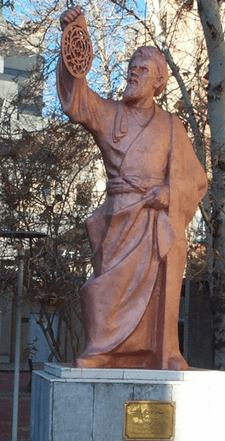 | |
| Born | c. 780 |
| Died | c. 850 |
| Academic work | |
| Era | Medieval era (Islamic Golden Age) |
| Main interests | Mathematics, Geography, Astronomy |
| Notable works | The Compendious Book on Calculation by Completion and Balancing, Book of the Description of the Earth, Astronomical tables of Siddhanta |
| Notable ideas | Treatises on algebra and Indian numerals |
| Influenced | Abu Kamil[1] |
Al-Khwarizmi's popularizing treatise on algebra (The Compendious Book on Calculation by Completion and Balancing, c. 813–833 CE[6]:171) presented the first systematic solution of linear and quadratic equations. One of his principal achievements in algebra was his demonstration of how to solve quadratic equations by completing the square, for which he provided geometric justifications.[5]:14 Because he was the first to treat algebra as an independent discipline and introduced the methods of "reduction" and "balancing" (the transposition of subtracted terms to the other side of an equation, that is, the cancellation of like terms on opposite sides of the equation),[7] he has been described as the father[2][8][9] or founder[10][11] of algebra. The term algebra itself comes from the title of his book (the word al-jabr meaning "completion" or "rejoining").[12] His name gave rise to the terms algorism and algorithm,.[13] as well as Spanish guarismo[14] and Portuguese algarismo meaning "digit".
In the 12th century, Latin translations of his textbook on arithmetic (Algorithmo de Numero Indorum) which codified the various Indian numerals, introduced the decimal positional number system to the Western world.[15] The Compendious Book on Calculation by Completion and Balancing, translated into Latin by Robert of Chester in 1145, was used until the sixteenth century as the principal mathematical text-book of European universities.[16][17][18][19]
In addition to his best-known works, he revised Ptolemy's Geography, listing the longitudes and latitudes of various cities and localities.[20]:9 He further produced a set of astronomical tables and wrote about calendaric works, as well as the astrolabe and the sundial.[21]:669 He also made important contributions to trigonometry, producing accurate sine and cosine tables, and the first table of tangents.
Life
Few details of al-Khwārizmī's life are known with certainty. He was born into a Persian family[4] and Ibn al-Nadim gives his birthplace as Khwarezm[22] in Greater Khorasan (modern Khiva, Xorazm Region, Uzbekistan).
Muhammad ibn Jarir al-Tabari gives his name as Muḥammad ibn Musá al-Khwārizmiyy al-Majūsiyy al-Quṭrubbaliyy (محمد بن موسى الخوارزميّ المجوسـيّ القطربّـليّ). The epithet al-Qutrubbulli could indicate he might instead have come from Qutrubbul (Qatrabbul),[23] a viticulture district near Baghdad. However, Rashed denies this:[24]
There is no need to be an expert on the period or a philologist to see that al-Tabari's second citation should read "Muhammad ibn Mūsa al-Khwārizmī and al-Majūsi al-Qutrubbulli," and that there are two people (al-Khwārizmī and al-Majūsi al-Qutrubbulli) between whom the letter wa [Arabic 'و' for the conjunction 'and'] has been omitted in an early copy. This would not be worth mentioning if a series of errors concerning the personality of al-Khwārizmī, occasionally even the origins of his knowledge, had not been made. Recently, G.J. Toomer ... with naive confidence constructed an entire fantasy on the error which cannot be denied the merit of amusing the reader.
Regarding al-Khwārizmī's religion, Toomer writes:[25]
Another epithet given to him by al-Ṭabarī, "al-Majūsī," would seem to indicate that he was an adherent of the old Zoroastrian religion. This would still have been possible at that time for a man of Iranian origin, but the pious preface to al-Khwārizmī's Algebra shows that he was an orthodox Muslim, so al-Ṭabarī's epithet could mean no more than that his forebears, and perhaps he in his youth, had been Zoroastrians.
Ibn al-Nadīm's Kitāb al-Fihrist includes a short biography on al-Khwārizmī together with a list his books. Al-Khwārizmī accomplished most of his work between 813 and 833. After the Muslim conquest of Persia, Baghdad had become the centre of scientific studies and trade, and many merchants and scientists from as far as China and India traveled there, as did al-Khwārizmī . He worked in the House of Wisdom established by the Abbasid Caliph al-Ma’mūn, where he studied the sciences and mathematics, including the translation of Greek and Sanskrit scientific manuscripts.
Douglas Morton Dunlop suggests that Muḥammad ibn Mūsā al-Khwārizmī might have been the same person as Muḥammad ibn Mūsā ibn Shākir, the eldest of the three Banū Mūsā.[26]
Contributions
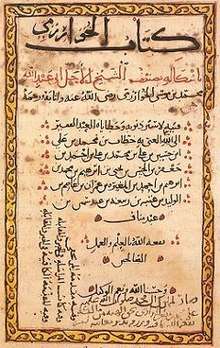
Al-Khwārizmī's contributions to mathematics, geography, astronomy, and cartography established the basis for innovation in algebra and trigonometry. His systematic approach to solving linear and quadratic equations led to algebra, a word derived from the title of his book on the subject, "The Compendious Book on Calculation by Completion and Balancing".[27]
On the Calculation with Hindu Numerals written about 820, was principally responsible for spreading the Hindu–Arabic numeral system throughout the Middle East and Europe. It was translated into Latin as Algoritmi de numero Indorum. Al-Khwārizmī, rendered as (Latin) Algoritmi, led to the term "algorithm".
Some of his work was based on Persian and Babylonian astronomy, Indian numbers, and Greek mathematics.
Al-Khwārizmī systematized and corrected Ptolemy's data for Africa and the Middle East. Another major book was Kitab surat al-ard ("The Image of the Earth"; translated as Geography), presenting the coordinates of places based on those in the Geography of Ptolemy but with improved values for the Mediterranean Sea, Asia, and Africa.
He also wrote on mechanical devices like the astrolabe and sundial.
He assisted a project to determine the circumference of the Earth and in making a world map for al-Ma'mun, the caliph, overseeing 70 geographers.[28]
When, in the 12th century, his works spread to Europe through Latin translations, it had a profound impact on the advance of mathematics in Europe.
Algebra
.png)
.png)
The Compendious Book on Calculation by Completion and Balancing (Arabic: الكتاب المختصر في حساب الجبر والمقابلة al-Kitāb al-mukhtaṣar fī ḥisāb al-jabr wal-muqābala) is a mathematical book written approximately 820 CE. The book was written with the encouragement of Caliph al-Ma'mun as a popular work on calculation and is replete with examples and applications to a wide range of problems in trade, surveying and legal inheritance.[29] The term "algebra" is derived from the name of one of the basic operations with equations (al-jabr, meaning "restoration", referring to adding a number to both sides of the equation to consolidate or cancel terms) described in this book. The book was translated in Latin as Liber algebrae et almucabala by Robert of Chester (Segovia, 1145) hence "algebra", and also by Gerard of Cremona. A unique Arabic copy is kept at Oxford and was translated in 1831 by F. Rosen. A Latin translation is kept in Cambridge.[30]
It provided an exhaustive account of solving polynomial equations up to the second degree,[31] and discussed the fundamental methods of "reduction" and "balancing", referring to the transposition of terms to the other side of an equation, that is, the cancellation of like terms on opposite sides of the equation.[32]
Al-Khwārizmī's method of solving linear and quadratic equations worked by first reducing the equation to one of six standard forms (where b and c are positive integers)
- squares equal roots (ax2 = bx)
- squares equal number (ax2 = c)
- roots equal number (bx = c)
- squares and roots equal number (ax2 + bx = c)
- squares and number equal roots (ax2 + c = bx)
- roots and number equal squares (bx + c = ax2)
by dividing out the coefficient of the square and using the two operations al-jabr (Arabic: الجبر "restoring" or "completion") and al-muqābala ("balancing"). Al-jabr is the process of removing negative units, roots and squares from the equation by adding the same quantity to each side. For example, x2 = 40x − 4x2 is reduced to 5x2 = 40x. Al-muqābala is the process of bringing quantities of the same type to the same side of the equation. For example, x2 + 14 = x + 5 is reduced to x2 + 9 = x.
The above discussion uses modern mathematical notation for the types of problems that the book discusses. However, in al-Khwārizmī's day, most of this notation had not yet been invented, so he had to use ordinary text to present problems and their solutions. For example, for one problem he writes, (from an 1831 translation)
If some one says: "You divide ten into two parts: multiply the one by itself; it will be equal to the other taken eighty-one times." Computation: You say, ten less a thing, multiplied by itself, is a hundred plus a square less twenty things, and this is equal to eighty-one things. Separate the twenty things from a hundred and a square, and add them to eighty-one. It will then be a hundred plus a square, which is equal to a hundred and one roots. Halve the roots; the moiety is fifty and a half. Multiply this by itself, it is two thousand five hundred and fifty and a quarter. Subtract from this one hundred; the remainder is two thousand four hundred and fifty and a quarter. Extract the root from this; it is forty-nine and a half. Subtract this from the moiety of the roots, which is fifty and a half. There remains one, and this is one of the two parts.[29]
In modern notation this process, with x the "thing" (شيء shayʾ) or "root", is given by the steps,
Let the roots of the equation be x = p and x = q. Then , and
So a root is given by
Several authors have also published texts under the name of Kitāb al-jabr wal-muqābala, including Abū Ḥanīfa Dīnawarī, Abū Kāmil Shujāʿ ibn Aslam, Abū Muḥammad al-‘Adlī, Abū Yūsuf al-Miṣṣīṣī, 'Abd al-Hamīd ibn Turk, Sind ibn ‘Alī, Sahl ibn Bišr, and Sharaf al-Dīn al-Ṭūsī.
J.J. O'Conner and E.F. Robertson wrote in the MacTutor History of Mathematics archive:
Perhaps one of the most significant advances made by Arabic mathematics began at this time with the work of al-Khwarizmi, namely the beginnings of algebra. It is important to understand just how significant this new idea was. It was a revolutionary move away from the Greek concept of mathematics which was essentially geometry. Algebra was a unifying theory which allowed rational numbers, irrational numbers, geometrical magnitudes, etc., to all be treated as "algebraic objects". It gave mathematics a whole new development path so much broader in concept to that which had existed before, and provided a vehicle for future development of the subject. Another important aspect of the introduction of algebraic ideas was that it allowed mathematics to be applied to itself in a way which had not happened before.[33]
R. Rashed and Angela Armstrong write:
Al-Khwarizmi's text can be seen to be distinct not only from the Babylonian tablets, but also from Diophantus' Arithmetica. It no longer concerns a series of problems to be solved, but an exposition which starts with primitive terms in which the combinations must give all possible prototypes for equations, which henceforward explicitly constitute the true object of study. On the other hand, the idea of an equation for its own sake appears from the beginning and, one could say, in a generic manner, insofar as it does not simply emerge in the course of solving a problem, but is specifically called on to define an infinite class of problems.[34]
According to Swiss-American historian of mathematics, Florian Cajori, Al-Khwarizmi's algebra was different from the work of Indian mathematicians, for Indians had no rules like the ''restoration'' and ''reduction''.[35] Regarding the dissimilarity and significance of Al-Khwarizmi's algebraic work from that of Indian Mathematician Brahmagupta, Carl Benjamin Boyer wrote:
It is true that in two respects the work of al-Khowarizmi represented a retrogression from that of Diophantus. First, it is on a far more elementary level than that found in the Diophantine problems and, second, the algebra of al-Khowarizmi is thoroughly rhetorical, with none of the syncopation found in the Greek Arithmetica or in Brahmagupta's work. Even numbers were written out in words rather than symbols! It is quite unlikely that al-Khwarizmi knew of the work of Diophantus, but he must have been familiar with at least the astronomical and computational portions of Brahmagupta; yet neither al-Khwarizmi nor other Arabic scholars made use of syncopation or of negative numbers. Nevertheless, the Al-jabr comes closer to the elementary algebra of today than the works of either Diophantus or Brahmagupta, because the book is not concerned with difficult problems in indeterminant analysis but with a straight forward and elementary exposition of the solution of equations, especially that of second degree. The Arabs in general loved a good clear argument from premise to conclusion, as well as systematic organization – respects in which neither Diophantus nor the Hindus excelled.[36]
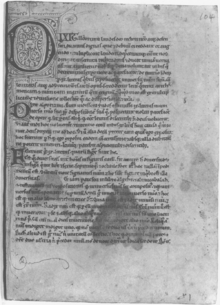
Arithmetic
.png)
Al-Khwārizmī's second most influential work was on the subject of arithmetic, which survived in Latin translations but lost in the original Arabic. His writings include the text kitāb al-ḥisāb al-hindī ('Book of Indian computation'[note 2]), and perhaps a more elementary text, kitab al-jam' wa'l-tafriq al-ḥisāb al-hindī ('Addition and subtraction in Indian arithmetic').[38][39] These texts described algorithms on decimal numbers (Hindu–Arabic numerals) that could be carried out on a dust board. Called takht in Arabic (Latin: tabula), a board covered with a thin layer of dust or sand was employed for calculations, on which figures could be written with a stylus and easily erased and replaced when necessary. Al-Khwarizmi's algorithms were used for almost three centuries, until replaced by Al-Uqlidisi's algorithms that could be carried out with pen and paper.[40]
As part of 12th century wave of Arabic science flowing into Europe via translations, these texts proved to be revolutionary in Europe.[41] Al-Khwarizmi's Latinized name, Algorismus, turned into the name of method used for computations, and survives in the modern term "algorithm". It gradually replaced the previous abacus-based methods used in Europe.[42]
Four Latin texts providing adaptions of Al-Khwarizmi's methods have survived, even though none of them is believed to be a literal translation:[38]
- Dixit Algorizmi (published in 1857 under the title Algoritmi de Numero Indorum[43])[44]
- Liber Alchoarismi de Practica Arismetice
- Liber Ysagogarum Alchorismi
- Liber Pulveris
Dixit Algorizmi ('Thus spake Al-Khwarizmi') is the starting phrase of a manuscript in the University of Cambridge library, which is generally referred to by its 1857 title Algoritmi de Numero Indorum. It is attributed to the Adelard of Bath, who had also translated the astronomical tables in 1126. It is perhaps the closest to Al-Khwarizmi's own writings.[44]
Al-Khwarizmi's work on arithmetic was responsible for introducing the Arabic numerals, based on the Hindu–Arabic numeral system developed in Indian mathematics, to the Western world. The term "algorithm" is derived from the algorism, the technique of performing arithmetic with Hindu-Arabic numerals developed by al-Khwārizmī. Both "algorithm" and "algorism" are derived from the Latinized forms of al-Khwārizmī's name, Algoritmi and Algorismi, respectively.
Astronomy
.png)
Al-Khwārizmī's Zīj al-Sindhind[45] (Arabic: زيج السند هند, "astronomical tables of Siddhanta"[46]) is a work consisting of approximately 37 chapters on calendrical and astronomical calculations and 116 tables with calendrical, astronomical and astrological data, as well as a table of sine values. This is the first of many Arabic Zijes based on the Indian astronomical methods known as the sindhind.[47] The work contains tables for the movements of the sun, the moon and the five planets known at the time. This work marked the turning point in Islamic astronomy. Hitherto, Muslim astronomers had adopted a primarily research approach to the field, translating works of others and learning already discovered knowledge.
The original Arabic version (written c. 820) is lost, but a version by the Spanish astronomer Maslamah Ibn Ahmad al-Majriti (c. 1000) has survived in a Latin translation, presumably by Adelard of Bath (January 26, 1126).[48] The four surviving manuscripts of the Latin translation are kept at the Bibliothèque publique (Chartres), the Bibliothèque Mazarine (Paris), the Biblioteca Nacional (Madrid) and the Bodleian Library (Oxford).
Trigonometry
Al-Khwārizmī's Zīj al-Sindhind also contained tables for the trigonometric functions of sines and cosine.[47] A related treatise on spherical trigonometry is also attributed to him.[33]
Al-Khwārizmī produced accurate sine and cosine tables, and the first table of tangents.[49][50]
Geography
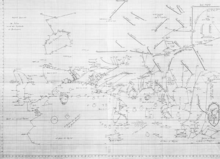
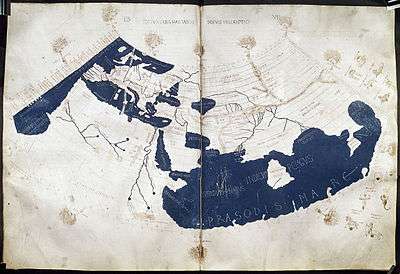
.png)
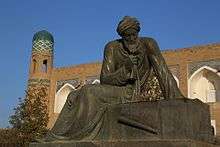
Al-Khwārizmī's third major work is his Kitāb Ṣūrat al-Arḍ (Arabic: كتاب صورة الأرض, "Book of the Description of the Earth"),[51] also known as his Geography, which was finished in 833. It is a major reworking of Ptolemy's 2nd-century Geography, consisting of a list of 2402 coordinates of cities and other geographical features following a general introduction.[52]
There is only one surviving copy of Kitāb Ṣūrat al-Arḍ, which is kept at the Strasbourg University Library. A Latin translation is kept at the Biblioteca Nacional de España in Madrid. The book opens with the list of latitudes and longitudes, in order of "weather zones", that is to say in blocks of latitudes and, in each weather zone, by order of longitude. As Paul Gallez points out, this excellent system allows the deduction of many latitudes and longitudes where the only extant document is in such a bad condition as to make it practically illegible. Neither the Arabic copy nor the Latin translation include the map of the world itself; however, Hubert Daunicht was able to reconstruct the missing map from the list of coordinates. Daunicht read the latitudes and longitudes of the coastal points in the manuscript, or deduces them from the context where they were not legible. He transferred the points onto graph paper and connected them with straight lines, obtaining an approximation of the coastline as it was on the original map. He then does the same for the rivers and towns.[53]
Al-Khwārizmī corrected Ptolemy's gross overestimate for the length of the Mediterranean Sea[54] from the Canary Islands to the eastern shores of the Mediterranean; Ptolemy overestimated it at 63 degrees of longitude, while al-Khwārizmī almost correctly estimated it at nearly 50 degrees of longitude. He "also depicted the Atlantic and Indian Oceans as open bodies of water, not land-locked seas as Ptolemy had done."[55] Al-Khwārizmī's Prime Meridian at the Fortunate Isles was thus around 10° east of the line used by Marinus and Ptolemy. Most medieval Muslim gazetteers continued to use al-Khwārizmī's prime meridian.[54]
Jewish calendar
Al-Khwārizmī wrote several other works including a treatise on the Hebrew calendar, titled Risāla fi istikhrāj ta’rīkh al-yahūd (Arabic: رسالة في إستخراج تأريخ اليهود, "Extraction of the Jewish Era"). It describes the Metonic cycle, a 19-year intercalation cycle; the rules for determining on what day of the week the first day of the month Tishrei shall fall; calculates the interval between the Anno Mundi or Jewish year and the Seleucid era; and gives rules for determining the mean longitude of the sun and the moon using the Hebrew calendar. Similar material is found in the works of Abū Rayḥān al-Bīrūnī and Maimonides.[45]
Other works
Ibn al-Nadim's Kitāb al-Fihrist, an index of Arabic books, mentions al-Khwārizmī's Kitāb al-Taʾrīkh (Arabic: كتاب التأريخ), a book of annals. No direct manuscript survives; however, a copy had reached Nusaybin by the 11th century, where its metropolitan bishop, Mar Elyas bar Shinaya, found it. Elias's chronicle quotes it from "the death of the Prophet" through to 169 AH, at which point Elias's text itself hits a lacuna.[56]
Several Arabic manuscripts in Berlin, Istanbul, Tashkent, Cairo and Paris contain further material that surely or with some probability comes from al-Khwārizmī. The Istanbul manuscript contains a paper on sundials; the Fihrist credits al-Khwārizmī with Kitāb ar-Rukhāma(t) (Arabic: كتاب الرخامة). Other papers, such as one on the determination of the direction of Mecca, are on the spherical astronomy.
Two texts deserve special interest on the morning width (Ma‘rifat sa‘at al-mashriq fī kull balad) and the determination of the azimuth from a height (Ma‘rifat al-samt min qibal al-irtifā‘).
He also wrote two books on using and constructing astrolabes.
See also
| Wikiquote has quotations related to: al-Khwārizmī |
| Wikimedia Commons has media related to Muhammad ibn Musa al-Khwarizmi. |
- Al-Khwarizmi (crater) — A crater on the far side of the moon named for al-Khwārizmī.
Notes
- There is some confusion in the literature on whether al-Khwārizmī's full name is ابو عبد الله محمد بن موسى الخوارزمي Abū ʿAbdallāh Muḥammad ibn Mūsā al-Khwārizmī or ابو جعفر محمد بن موسی الخوارزمی Abū Ja‘far Muḥammad ibn Mūsā al-Khwārizmī. Ibn Khaldun notes in his encyclopedic work: "The first who wrote upon this branch [algebra] was Abu ‘Abdallah al-Khowarizmi, after whom came Abu Kamil Shoja‘ ibn Aslam." (MacGuckin de Slane) . In the introduction to his critical commentary on Robert of Chester's Latin translation of al-Khwārizmī's Algebra, L.C. Karpinski notes that Abū Ja‘far Muḥammad ibn Mūsā refers to the eldest of the Banū Mūsā brothers. Karpinski notes in his review on (Ruska 1917) that in (Ruska 1918): "Ruska here inadvertently speaks of the author as Abū Ga‘far M. b. M., instead of Abū Abdallah M. b. M."
- Some scholars translate the title al-ḥisāb al-hindī as "computation with Hindu numerals", but Arabic Hindī means 'Indian' rather than 'Hindu'. A. S. Saidan states that it should be understood as arithmetic done "in the Indian way", with Hindu-Arabic numerals, rather than as simply "Indian arithmetic". The Arab mathematicians incorporated their own innovations in their texts.[37]
References
- O'Connor, John J.; Robertson, Edmund F., "Abū Kāmil Shujā‘ ibn Aslam", MacTutor History of Mathematics archive, University of St Andrews.
- Corbin, Henry (1998). The Voyage and the Messenger: Iran and Philosophy. North Atlantic Books. p. 44. ISBN 978-1-55643-269-9.
- Clifford A. Pickover (2009). The Math Book: From Pythagoras to the 57th Dimension, 250 Milestones in the History of Mathematics. Sterling Publishing Company, Inc. p. 84. ISBN 978-1-4027-5796-9.
- Saliba, George (September 1998). "Science and medicine". Iranian Studies. 31 (3–4): 681–690. doi:10.1080/00210869808701940.
Take, for example, someone like Muhammad b. Musa al-Khwarizmi (fl. 850) who may present a problem for the EIr, for although he was obviously of Persian descent, he lived and worked in Baghdad and was not known to have produced a single scientific work in Persian.
- Maher, P. (1998). From Al-Jabr to Algebra. Mathematics in School, 27(4), 14–15.
- Oaks, J. (2009). Polynomials and equations in Arabic algebra. Archive for History of Exact Sciences, 63(2), 169–203.
- (Boyer 1991, "The Arabic Hegemony" p. 229) "It is not certain just what the terms al-jabr and muqabalah mean, but the usual interpretation is similar to that implied in the translation above. The word al-jabr presumably meant something like "restoration" or "completion" and seems to refer to the transposition of subtracted terms to the other side of an equation; the word muqabalah is said to refer to "reduction" or "balancing" – that is, the cancellation of like terms on opposite sides of the equation."
- Boyer, Carl B., 1985. A History of Mathematics, p. 252. Princeton University Press. "Diophantus sometimes is called the father of algebra, but this title more appropriately belongs to al-Khowarizmi..." , "...the Al-jabr comes closer to the elementary algebra of today than the works of either Diophantus or Brahmagupta..."
- S Gandz, The sources of al-Khwarizmi's algebra, Osiris, i (1936), 263–277,"Al-Khwarizmi's algebra is regarded as the foundation and cornerstone of the sciences. In a sense, al-Khwarizmi is more entitled to be called "the father of algebra" than Diophantus because al-Khwarizmi is the first to teach algebra in an elementary form and for its own sake, Diophantus is primarily concerned with the theory of numbers."
- Katz, Victor J. "STAGES IN THE HISTORY OF ALGEBRA WITH IMPLICATIONSFOR TEACHING" (PDF). VICTOR J.KATZ, University of the District of Columbia Washington DC, USA: 190. Archived from the original (PDF) on 2019-03-27. Retrieved 2017-10-07 – via University of the District of Columbia Washington DC, USA.
The first true algebra text which is still extant is the work on al-jabr and al-muqabala by Mohammad ibn Musa al-Khwarizmi, written in Baghdad around 825.
- Esposito, John L. (2000-04-06). The Oxford History of Islam. Oxford University Press. p. 188. ISBN 978-0-19-988041-6.
Al-Khwarizmi is often considered the founder of algebra, and his name gave rise to the term algorithm.
- Brentjes, Sonja (2007-06-01). "Algebra". Encyclopaedia of Islam, THREE.
- Daffa 1977
- Knuth, Donald (1979). Algorithms in Modern Mathematics and Computer Science (PDF). Springer-Verlag. ISBN 978-0-387-11157-5. Archived from the original (PDF) on 2006-11-07.
- Struik 1987, p. 93
- Philip Khuri Hitti (2002). History of the Arabs. p. 379. ISBN 978-1-137-03982-8.
- Fred James Hill, Nicholas Awde (2003). A History of the Islamic World. Hippocrene Books. p. 55. ISBN 978-0-7818-1015-9.
"The Compendious Book on Calculation by Completion and Balancing" (Hisab al-Jabr wa H-Muqabala) on the development of the subject cannot be underestimated. Translated into Latin during the twelfth century, it remained the principal mathematics textbook in European universities until the sixteenth century
- Shawn Overbay, Jimmy Schorer, and Heather Conger, University of Kentucky. "Al-Khwarizmi". Archived from the original on 2013-12-12.CS1 maint: multiple names: authors list (link)
- "Islam Spain and the history of technology". www.sjsu.edu. Retrieved 2018-01-24.
- L., V.D. (1985). A history of algebra: from al – Khwarizmi to emmy noether. Berlin: Springer-Verlag.
- Cristopher Moore and Stephan Mertens, The Nature of Computation, (Oxford University Press, 2011), 36.
- "Iraq After the Muslim Conquest", by Michael G. Morony, ISBN 1-59333-315-3 (a 2005 facsimile from the original 1984 book), p. 145
- Rashed, Roshdi (1988). "al-Khwārizmī's Concept of Algebra". In Zurayq, Qusṭanṭīn; Atiyeh, George Nicholas; Oweiss, Ibrahim M. (eds.). Arab Civilization: Challenges and Responses : Studies in Honor of Constantine K. Zurayk. SUNY Press. p. 108. ISBN 978-0-88706-698-6.CS1 maint: ref=harv (link)
- Toomer 1990
- Dunlop 1943
- "Mathematics Education in Iran From Ancient to Modern" (PDF). Shima Salehi ( Stanford University ), Yahya Tabesh ( Sharif University of Technology ).CS1 maint: others (link)
- "al-Khwarizmi". Encyclopædia Britannica. Retrieved 2008-05-30.
- Rosen, Frederic. "The Compendious Book on Calculation by Completion and Balancing, al-Khwārizmī". 1831 English Translation. Retrieved 2009-09-14.
- Karpinski, L.C. (1912). "History of Mathematics in the Recent Edition of the Encyclopædia Britannica". Science. 35 (888): 29–31. Bibcode:1912Sci....35...29K. doi:10.1126/science.35.888.29. PMID 17752897.CS1 maint: ref=harv (link)
- Boyer, Carl B. (1991). "The Arabic Hegemony". A History of Mathematics (Second ed.). John Wiley & Sons, Inc. p. 228. ISBN 978-0-471-54397-8.
"The Arabs in general loved a good clear argument from premise to conclusion, as well as systematic organization — respects in which neither Diophantus nor the Hindus excelled."
- (Boyer 1991, "The Arabic Hegemony" p. 229) "It is not certain just what the terms al-jabr and muqabalah mean, but the usual interpretation is similar to that implied in the translation above. The word al-jabr presumably meant something like "restoration" or "completion" and seems to refer to the transposition of subtracted terms to the other side of an equation; the word muqabalah is said to refer to "reduction" or "balancing" — that is, the cancellation of like terms on opposite sides of the equation."
- O'Connor, John J.; Robertson, Edmund F., "Muhammad ibn Musa al-Khwarizmi", MacTutor History of Mathematics archive, University of St Andrews.
- Rashed, R.; Armstrong, Angela (1994). The Development of Arabic Mathematics. Springer. pp. 11–12. ISBN 978-0-7923-2565-9. OCLC 29181926.CS1 maint: ref=harv (link)
- Florian Cajori (1919). A History of Mathematics. Macmillan. p. 103.
That it came from Indian source is impossible, for Hindus had no rules like "restoration" and "reduction". They were never in the habit of making all terms in an equation positive, as is done in the process of "restoration.
- Carl Benjamin Boyer (1968). A History of Mathematics. p. 252.
- Saidan, A. S. (Winter 1966), "The Earliest Extant Arabic Arithmetic: Kitab al-Fusul fi al Hisab al-Hindi of Abu al-Hasan, Ahmad ibn Ibrahim al-Uqlidisi", Isis, The University of Chicago Press, 57 (4): 475–490, doi:10.1086/350163, JSTOR 228518
- Burnett 2017, p. 39.
- Avari, Burjor (2013), Islamic Civilization in South Asia: A history of Muslim power and presence in the Indian subcontinent, Routledge, pp. 31–32, ISBN 978-0-415-58061-8
- Van Brummelen, Glen (2017), "Arithmetic", in Thomas F. Glick (ed.), Routledge Revivals: Medieval Science, Technology and Medicine (2006): An Encyclopedia, Taylor & Francis, p. 46, ISBN 978-1-351-67617-5
- Thomas F. Glick, ed. (2017), "Al-Khwarizmi", Routledge Revivals: Medieval Science, Technology and Medicine (2006): An Encyclopedia, Taylor & Francis, ISBN 978-1-351-67617-5
- Van Brummelen, Glen (2017), "Arithmetic", in Thomas F. Glick (ed.), Routledge Revivals: Medieval Science, Technology and Medicine (2006): An Encyclopedia, Taylor & Francis, pp. 46–47, ISBN 978-1-351-67617-5
- "Algoritmi de numero Indorum", Trattati D'Aritmetica, Rome: Tipografia delle Scienze Fisiche e Matematiche, 1857, pp. 1–
- Crossley, John N.; Henry, Alan S. (1990), "Thus Spake al-Khwārizmī: A Translation of the Text of Cambridge University Library Ms. Ii.vi.5", Historia Mathematica, 17 (2): 103–131, doi:10.1016/0315-0860(90)90048-I
- Thurston, Hugh (1996), Early Astronomy, Springer Science & Business Media, pp. 204–, ISBN 978-0-387-94822-5
- Kennedy 1956, pp. 26–29
- Kennedy 1956, p. 128
- Jacques Sesiano, "Islamic mathematics", p. 157, in Selin, Helaine; D'Ambrosio, Ubiratan, eds. (2000). Mathematics Across Cultures: The History of Non-western Mathematics. Springer Science+Business Media. ISBN 978-1-4020-0260-1.
- "trigonometry". Encyclopædia Britannica. Retrieved 2008-07-21.
- The full title is "The Book of the Description of the Earth, with its Cities, Mountains, Seas, All the Islands and the Rivers, written by Abu Ja'far Muhammad ibn Musa al-Khwārizmī, according to the Geographical Treatise written by Ptolemy the Claudian", although due to ambiguity in the word surah it could also be understood as meaning "The Book of the Image of the Earth" or even "The Book of the Map of the World".
- "The history of cartography". GAP computer algebra system. Archived from the original on 2008-05-24. Retrieved 2008-05-30.
- Daunicht.
- Edward S. Kennedy, Mathematical Geography, p. 188, in (Rashed & Morelon 1996, pp. 185–201)
- Covington, Richard (2007). "The Third Dimension". Saudi Aramco World, May–June 2007: 17–21. Archived from the original on 2008-05-12. Retrieved 2008-07-06.CS1 maint: ref=harv (link)
- LJ Delaporte (1910). Chronographie de Mar Elie bar Sinaya. Paris. p. xiii.
Further reading
Specific references
- Biographical
- Toomer, Gerald (1990). "Al-Khwārizmī, Abu Ja'far Muḥammad ibn Mūsā". In Gillispie, Charles Coulston (ed.). Dictionary of Scientific Biography. 7. New York: Charles Scribner's Sons. ISBN 978-0-684-16962-0.CS1 maint: ref=harv (link)
- Brentjes, Sonja (2007). "Khwārizmī: Muḥammad ibn Mūsā al‐Khwārizmī" in Thomas Hockey et al.(eds.). The Biographical Encyclopedia of Astronomers, Springer Reference. New York: Springer, 2007, pp. 631–633. (PDF version)
- Dunlop, Douglas Morton (1943). "Muḥammad b. Mūsā al-Khwārizmī". The Journal of the Royal Asiatic Society of Great Britain and Ireland (2): 248–250. doi:10.1017/S0035869X00098464. JSTOR 25221920.CS1 maint: ref=harv (link)
- Hogendijk, Jan P., Muhammad ibn Musa (Al-)Khwarizmi (c. 780–850 CE) – bibliography of his works, manuscripts, editions and translations.
- O'Connor, John J.; Robertson, Edmund F., "Abu Ja'far Muhammad ibn Musa Al-Khwarizmi", MacTutor History of Mathematics archive, University of St Andrews.
- Fuat Sezgin. Geschichte des arabischen Schrifttums. 1974, E.J. Brill, Leiden, the Netherlands.
- Sezgin, F., ed., Islamic Mathematics and Astronomy, Frankfurt: Institut für Geschichte der arabisch-islamischen Wissenschaften, 1997–99.
- Algebra
- Gandz, Solomon (November 1926). "The Origin of the Term "Algebra"". The American Mathematical Monthly. 33 (9): 437–440. doi:10.2307/2299605. ISSN 0002-9890. JSTOR 2299605.CS1 maint: ref=harv (link)
- Gandz, Solomon (1936). "The Sources of al-Khowārizmī's Algebra". Osiris. 1 (1): 263–277. doi:10.1086/368426. ISSN 0369-7827. JSTOR 301610.CS1 maint: ref=harv (link)
- Gandz, Solomon (1938). "The Algebra of Inheritance: A Rehabilitation of Al-Khuwārizmī". Osiris. 5 (5): 319–391. doi:10.1086/368492. ISSN 0369-7827. JSTOR 301569.CS1 maint: ref=harv (link)
- Hughes, Barnabas (1986). "Gerard of Cremona's Translation of al-Khwārizmī's al-Jabr: A Critical Edition". Mediaeval Studies. 48: 211–263. doi:10.1484/J.MS.2.306339.CS1 maint: ref=harv (link)
- Barnabas Hughes. Robert of Chester's Latin translation of al-Khwarizmi's al-Jabr: A new critical edition. In Latin. F. Steiner Verlag Wiesbaden (1989). ISBN 3-515-04589-9.
- {{cite book|first=L.C.|last=Karpinski|authorlink=L. C. Karpinski|title=Robert of Chester's Latin Translation of the Algebra of Al-Khowarizmi: With an Introduction, Critical Notes and an English Version|date=1915|publisher=The Macmillan Company|url=https://library.albany.edu/preservation/brittlebooks}
- Rosen, Fredrick (1831). The Algebra of Mohammed Ben Musa. Kessinger Publishing. ISBN 978-1-4179-4914-4.CS1 maint: ref=harv (link)
- Ruska, Julius (1917). "Zur ältesten arabischen Algebra und Rechenkunst". Sitzungsberichte der Heidelberger Akademie der Wissenschaften, Philosophisch-historische Klasse. Sitzungsberichte der Heidelberger Akademie der Wissenschaften. Philologisch-historische Klasse. Jahr. 1917,2. Abh: 1–125.CS1 maint: ref=harv (link)
- Arithmetic
- Burnett, Charles (2017), "Arabic Numerals", in Thomas F. Glick (ed.), Routledge Revivals: Medieval Science, Technology and Medicine (2006): An Encyclopedia, Taylor & Francis, ISBN 978-1-351-67617-5
- Folkerts, Menso (1997). Die älteste lateinische Schrift über das indische Rechnen nach al-Ḫwārizmī (in German and Latin). München: Bayerische Akademie der Wissenschaften. ISBN 978-3-7696-0108-4.
- Vogel, Kurt (1968). Mohammed ibn Musa Alchwarizmi's Algorismus; das früheste Lehrbuch zum Rechnen mit indischen Ziffern. Nach der einzigen (lateinischen) Handschrift (Cambridge Un. Lib. Ms. Ii. 6.5) in Faksimile mit Transkription und Kommentar herausgegeben von Kurt Vogel. Aalen, O. Zeller.
- Astronomy
- Goldstein, B.R. (1968). Commentary on the Astronomical Tables of Al-Khwarizmi: By Ibn Al-Muthanna. Yale University Press. ISBN 978-0-300-00498-4.
- Hogendijk, Jan P. (1991). "Al-Khwārizmī's Table of the "Sine of the Hours" and the Underlying Sine Table". Historia Scientiarum. 42: 1–12.CS1 maint: ref=harv (link)
- King, David A. (1983). Al-Khwārizmī and New Trends in Mathematical Astronomy in the Ninth Century. New York University: Hagop Kevorkian Center for Near Eastern Studies: Occasional Papers on the Near East 2. Bibcode:1983antm.book.....K. LCCN 85150177.
- Neugebauer, Otto (1962). The Astronomical Tables of al-Khwarizmi.
- Rosenfeld, Boris A. (1993). Menso Folkerts; J.P. Hogendijk (eds.). "Geometric trigonometry" in treatises of al-Khwārizmī, al-Māhānī and Ibn al-Haytham. Vestiga Mathematica: Studies in Medieval and Early Modern Mathematics in Honour of H.L.L. Busard. Amsterdam: Rodopi. ISBN 978-90-5183-536-6.CS1 maint: ref=harv (link)
- Suter, Heinrich. [Ed.]: Die astronomischen Tafeln des Muhammed ibn Mûsâ al-Khwârizmî in der Bearbeitung des Maslama ibn Ahmed al-Madjrîtî und der latein. Übersetzung des Athelhard von Bath auf Grund der Vorarbeiten von A. Bjørnbo und R. Besthorn in Kopenhagen. Hrsg. und komm. Kopenhagen 1914. 288 pp. Repr. 1997 (Islamic Mathematics and Astronomy. 7). ISBN 3-8298-4008-X.
- Van Dalen, B. Al-Khwarizmi's Astronomical Tables Revisited: Analysis of the Equation of Time.
- Spherical trigonometry
- B.A. Rozenfeld. "Al-Khwarizmi's spherical trigonometry" (Russian), Istor.-Mat. Issled. 32–33 (1990), 325–339.
- Jewish calendar
- Kennedy, E. S. (1964). "Al-Khwārizmī on the Jewish Calendar". Scripta Mathematica. 27: 55–59.CS1 maint: ref=harv (link)
- Geography
- Daunicht, Hubert (1968–1970). Der Osten nach der Erdkarte al-Ḫuwārizmīs : Beiträge zur historischen Geographie und Geschichte Asiens (in German). Bonner orientalistische Studien. N.S.; Bd. 19. LCCN 71468286.
- Mžik, Hans von (1915). "Ptolemaeus und die Karten der arabischen Geographen". Mitteil. D. K. K. Geogr. Ges. In Wien. 58: 152.CS1 maint: ref=harv (link)
- Mžik, Hans von (1916). "Afrika nach der arabischen Bearbeitung der γεωγραφικὴ ὑφήγησις des Cl. Ptolomeaus von Muh. ibn Mūsa al-Hwarizmi". Denkschriften D. Akad. D. Wissen. In Wien, Phil.-hist. Kl. 59.CS1 maint: ref=harv (link)
- Mžik, Hans von (1926). Das Kitāb Ṣūrat al-Arḍ des Abū Ǧa'far Muḥammad ibn Mūsā al-Ḫuwārizmī. Leipzig.
- Nallino, C.A. (1896), "Al-Ḫuwārizmī e il suo rifacimento della Geografia di Tolemo", Atti della R. Accad. Dei Lincei, Arno 291, Serie V, Memorie, Classe di Sc. Mor., Vol. II, Rome
- Ruska, Julius (1918). "Neue Bausteine zur Geschichte der arabischen Geographie". Geographische Zeitschrift. 24: 77–81.CS1 maint: ref=harv (link)
- Spitta, W. (1879). "Ḫuwārizmī's Auszug aus der Geographie des Ptolomaeus". Zeitschrift Deutschen Morgenl. Gesell. 33.CS1 maint: ref=harv (link)
General references
- Berggren, J. Lennart (1986). Episodes in the Mathematics of Medieval Islam. New York: Springer Science+Business Media. ISBN 978-0-387-96318-1.CS1 maint: ref=harv (link)
- Boyer, Carl B. (1991). "The Arabic Hegemony". A History of Mathematics (Second ed.). John Wiley & Sons, Inc. ISBN 978-0-471-54397-8.
- Daffa, Ali Abdullah al- (1977). The Muslim contribution to mathematics. London: Croom Helm. ISBN 978-0-85664-464-1.CS1 maint: ref=harv (link)
- Dallal, Ahmad (1999). "Science, Medicine and Technology". In Esposito, John (ed.). The Oxford History of Islam. Oxford University Press, New York.CS1 maint: ref=harv (link)
- Kennedy, E.S. (1956). "A Survey of Islamic Astronomical Tables; Transactions of the American Philosophical Society". 46 (2). Philadelphia: American Philosophical Society. Cite journal requires
|journal=(help)CS1 maint: ref=harv (link) - King, David A. (1999a). "Islamic Astronomy". In Walker, Christopher (ed.). Astronomy before the telescope. British Museum Press. pp. 143–174. ISBN 978-0-7141-2733-0.CS1 maint: ref=harv (link)
- King, David A. (2002). "A Vetustissimus Arabic Text on the Quadrans Vetus". Journal for the History of Astronomy. 33 (112): 237–255. Bibcode:2002JHA....33..237K. doi:10.1177/002182860203300302.CS1 maint: ref=harv (link)
- Struik, Dirk Jan (1987). A Concise History of Mathematics (4th ed.). Dover Publications. ISBN 978-0-486-60255-4.CS1 maint: ref=harv (link)
- O'Connor, John J.; Robertson, Edmund F., "Abraham bar Hiyya Ha-Nasi", MacTutor History of Mathematics archive, University of St Andrews.
- O'Connor, John J.; Robertson, Edmund F., "Arabic mathematics: forgotten brilliance?", MacTutor History of Mathematics archive, University of St Andrews.
- Roshdi Rashed, The development of Arabic mathematics: between arithmetic and algebra, London, 1994.

